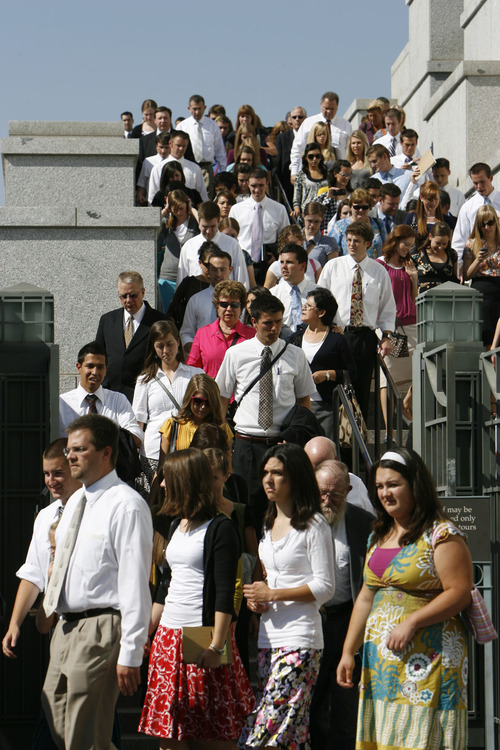This is an archived article that was published on sltrib.com in 2011, and information in the article may be outdated. It is provided only for personal research purposes and may not be reprinted.
Figures about the economic impact of LDS General Conference are notably lacking, but no doubt they are substantial.
They always have been and will be even more so in the future as membership in The Church of Jesus Christ of Latter-day Saints becomes more global, enticing additional non-Utahns to visit Salt Lake City for spring and fall gatherings.
"Twice a year, you can guarantee Salt Lake City hotels will fill up because of LDS General Conference," said Steve Lundgren, general manager of the Downtown Marriott Hotel, 75 S. West Temple.
Hotels certainly are a major beneficiary of the influx of visitors every April and October. Restaurants, too.
Although Utah Restaurant Association CEO Melva Sine has no hard figures on how much business increases on conference weekends, "we know every place is packed.
"On priesthood night," she said, referring to the session for adult and teenage males, "if you haven't made a reservation weeks in advance, it's difficult to find a place to go. You'll see people wait 40 minutes to an hour for a table."
LDS Church spokesman Scott Trotter said the church does not keep economic data, but noted that all five sessions of the big event fill the 21,200-seat LDS Conference Center. Crowds also spill into Temple Square, the Tabernacle, Assembly Hall and the Joseph Smith Memorial Building.
"General Conference is a time of rejoicing and spiritual reflection for Latter-day Saints, and we're appreciative of the more than 100,000 members from around the world who come to Salt Lake City for these important meetings," he said.
For conventions in general, the University of Utah's Bureau of Economic and Business Research figures the average delegate spends $923 during a three-day stay.
That would suggest an impact of $92 million, but that's probably too big for conference.
Many people attending sessions are Utahns. Whatever they spend isn't really economic impact because it is not outside money coming in. In addition, although conventioneers stay at hotels, many out-of-state conference visitors bunk with relatives or friends.
On the other hand, Marriott's Lundgren said that in the decade he has been in Salt Lake City, he has seen more national and international visitors come for conference — filling hotels farther out into Salt Lake City's suburbs.
"It's a special trip for them. As the church expands into new countries, we're seeing more people who want that conference experience," he said. "We're typically sold out Friday and Saturday, robust Thursday and reasonably robust Sunday. There's a lot of activity and people shopping."
Sine added that conference activity is not confined to downtown Salt Lake City.
"Even though the main thrust of the event is around the Temple and actually being able to see these amazing general authorities, we know that throughout the state, people are gathering in stake houses to listen," she said. "After those meetings, for the most part it's an evening out. People go to church, get great information and then go out and enjoy what's good in the community — and that usually means food."
But it's not always limited to eating.
Bob Brown, owner of the Cheers to You bar three blocks from the LDS Temple, swears his business goes up on conference weekends.
"It's not a sizable increase, just a percent, but I've always found that to be the case," he said, convinced it's errant conference-goers who boost sales.
"When you have a bar that's full of regulars, and new people come in who you haven't seen before, and they're clean cut, well-dressed, well-mannered people, you can put two and two together," Brown said.



